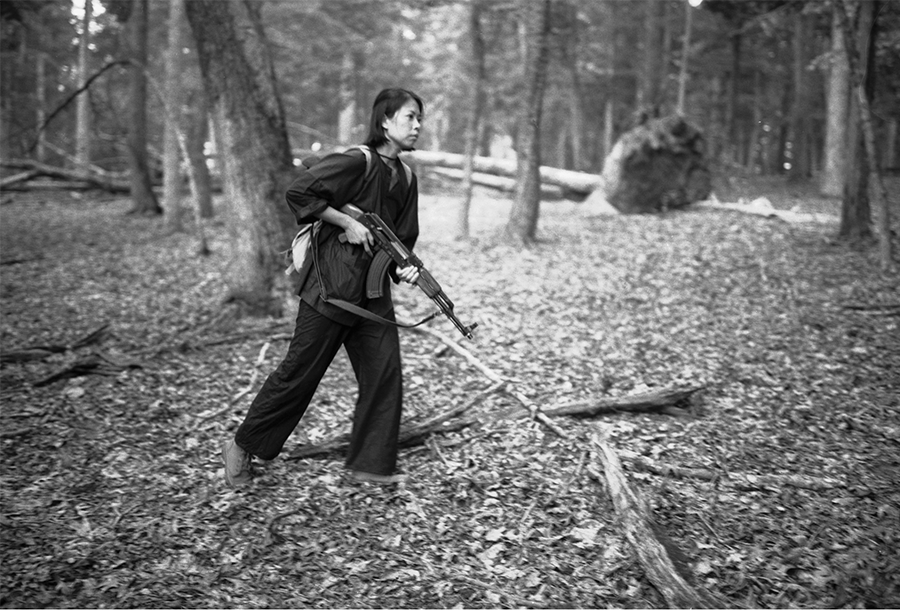Pamela Lee
The Art of Small War

An-My Lê, Untitled (a documentary photograph of the artist on site during a Vietnam War reenactment in Virginia), undated (c. 1999–2003), courtesy of An-My Lê
When a Trumpian mob stormed the US Capitol on January 6, 2021, it arguably committed an egregious act of “small war,” a notion theorized by Prussian general and military strategist Carl von Clausewitz (1780–1831) to describe martial conflicts waged between asymmetrically matched opponents: guerilla or “people’s” wars unfolding outside the conventional theater of operations. My book project departs from and enlarges the concept of small war to chart its quotidian impacts in contemporary art. In four chapters, I discuss artists including An-My Lê (b. 1960), Kevin Beasley (b. 1985), Lucy Raven (b. 1977), Tiona Nekkia McClodden (b. 1981), and Mel Chin (b. 1951) to address recent conditions trailing longer histories of small warfare and martial industry. From the epidemic of gun violence to the rise of militias, from the subjugation of nonhuman animal life in combat and beyond to the expanding terrain of military logistics, I regard these topics as linked episodes in a submerged genealogy of small war and art history.
If war is “perhaps the most organized of all human activities,” and has “stimulated further organization of society,” to follow the historian Margaret MacMillan, it stands to reason that its technologies and interests will be reproduced and reimagined across diverse artistic practices. The art historian appreciates the military valences of the term “avant-garde,” but is likely unfamiliar with Clausewitz’s analysis of its meanings relative to small war. “The Art of Small War” treats Clausewitz as a provocation for the history of art—not as a matter of influence nor an end in itself—while broadening the discipline’s reach to the study of militarism. Best known for the posthumously published On War (1832), Clausewitz and his lectures on small war have accrued enormous interest within military studies due to their acutely contemporary implications. His identification of phenomena associated with Napoleon’s campaigns resonates powerfully with current events in the United States and, to be sure, the world, including insurgency, the rise of militias, and new tactics stemming from developments in firearms technology.
“The Art of Small War” understands the experience of perpetual embattlement—the collective sensibility of always feeling “under siege”—as no mere metaphor of daily life but its organizing condition and first principle. It considers a diverse range of contemporary art, some treated in virtual colloquy with art of the 18th and early 19th centuries. During my residency at the Center, I researched and drafted the first chapter, “The Practice of Everyday War.” It opens with the scene of the January 6 insurrection in the rotunda of the US Capitol, in which a suite of history paintings by Colonel John Trumbull, founder of the Yale University Art Gallery and second aide-de-camp to George Washington, framed right-wing extremists fomenting on behalf of Donald Trump’s lost election. As a January/February 2022 article from The Atlantic argued, what unfolded that day was “practice”—a rehearsal for the next battle to come and the end of democracy. Convening a dissonant group of transhistorical actors, the chapter probes the unseemly convergence between aesthetic practice and the visual culture of patriotism and spectacle of contemporary militias. It recodes Michel de Certeau’s formative thesis in The Practice of Everyday Life (1984, English translation) as the practice of everyday war: de Certeau’s well-known discussion of “strategy” and “tactics” is in dialogue with Clausewitz. In addition to considering Trumbull’s historical example, my principal case study is the contemporary photographer An-My Lê. Lê’s important series on Vietnam War reenactors, Small Wars (1999–2002), sheds light on the practice of everyday war as both a domestic and domesticated phenomenon, centering the weaponization of time and history as both tactic and matériel.
Research for this chapter was wide-ranging given its expressly transhistorical nature, with materials ranging from 19th-century military literature to letters between a revolutionary artist and patriots of the early republic; to ephemera collected from the National Mall on January 7, 2021; to the work of a contemporary artist. A site-specific dimension—that is, taking advantage of resources in Washington, DC, continuous with my subject matter—informed my approach to both archival and recent material. On the one hand, exchanges with Lê were critical. Her 2023 retrospective at the Museum of Modern Art in New York provided foundational visual material, while interviews and archives unearthed new and previously unpublished information about her practice. Additional research was conducted in the archives of the Library of Congress, Yale University, Massachusetts Historical Society, and Smithsonian National Museum of American History.
Yale University
William C. Seitz Senior Fellow, 2023–2024
Pamela Lee will return to her position as the Carnegie Professor of Modern and Contemporary Art at Yale University.
